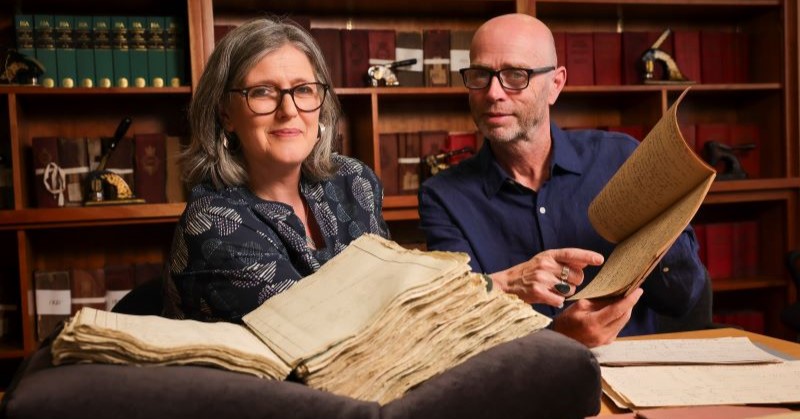Main pic, above: Zoë Reid, Keeper of Manuscripts, and Brian Gurrin, Population and Census Specialist, Virtual Record Treasury of Ireland, inspecting transcriptions in the National Archives of Ireland.
A recently discovered letter, seized in 1661 from a man traveling between Donegal Town and Barnesmore Gap, has surfaced in London.
This letter, written in Irish and dated June 1661, is among 175,000 newly released historical records by the Virtual Record Treasury of Ireland (VRTI) this week.
A copy of the original letter currently held in London. Credit: The National Archives UK TNA SP 63/307/2/194/D
These documents are now freely accessible online, commemorating the 103rd anniversary of the Four Courts fire which destroyed the Public Record Office of Ireland and seven centuries of Irish history.
Dr. Peter Crooks, a Trinity historian and Academic Director of VRTI, described the discovery of the Donegal letter as a ‘fascinating story’.
He explained that English authorities seized the letter from Neale MacDavid during his arrest. Unable to find a local interpreter due to it being written in Irish, it was sent to Dublin.
“They couldn’t get anybody local to interpret it and they thought this was highly suspicious,” he explained.
A section of the original letter currently held in London. Credit: The National Archives UK TNA SP 63/307/2/194/D
“This was in 1661, only 20 years after the 1641 Rebellion, so they sent it down to Dublin for investigation. It then gets sent over to London and when it finally gets translated it turns out to be a letter by the Franciscan Order saying Cromwell is dead, the new King has come in and their thinking is ‘maybe we can get better dispensation under the new Monarch coming in’. The letter relates to a proposed meeting of Franciscans in Mayo or Donegal and they hoped to reorganise their order under a more tolerant government.”
Dr. Crooks added that the English, unable to read the letter, deemed it suspicious, leading it to an intelligence file within the State Papers Ireland at The National Archives in London, where it remained for 400 years.
“And now it’s available online back in Ireland on www.virtualtreasury.ie,” he concluded.
The original translation and accompanying papers are all preserved.
Other Donegal highlights available on the Virtual Record Treasury include an 1891 Census map illustrating the ‘rateable valuation’ of land across Ireland. Donegal landowners paid 15 shillings, while those in Meath paid five times more.
Furthermore, the record features a 1670 proclamation (below) by the Lord Lieutenant, offering a £20 reward for the capture (dead or alive) of ‘certain proclaimed Tories and rebels’ in Donegal, Armagh, Tyrone, Monaghan, Fermanagh, Derry, Mayo, and Roscommon who fail to surrender.
A 1670 proclamation by the Lord Lieutenant offering a £20 reward for the apprehension (dead or alive) of ‘certain proclaimed Tories and rebels’ in counties including Donegal.
Launched three years ago, the Virtual Record Treasury of Ireland now hosts over 350,000 records and 250 million words of searchable Irish history. Led by Trinity College Dublin and supported by the Department of Culture, the project unites historians, computer scientists, archivists, and librarians in digitally recreating Ireland’s destroyed public record office and its lost collections.
Seventy-five memory institutions across Ireland and worldwide are contributing digital images of replacement documents – transcripts and duplicates – to the Virtual Treasury. Core partners include the National Archives of Ireland (NAI), Public Record Office of Northern Ireland (PRONI), The National Archives UK (TNA), the Irish Manuscripts Commission (IMC), and the Library of Trinity College Dublin.
Among the new treasures freely available online today for the first time are 60,000 names from the 19th-century census destroyed in 1922. Names from every county in Ireland are represented in the new Population Portal. Painstakingly compiled from transcriptions preserved in the National Archives of Ireland and the Public Record Office of Northern Ireland, these recovered transcripts of census returns reveal ordinary lives across the island of Ireland in the decades before and after the Great Famine.
Seventeenth century Donegal letter discovered in London ‘intelligence files’ was last modified: July 4th, 2025 by
Tags:


